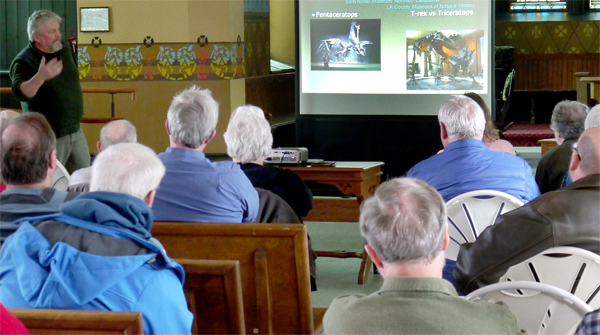Present-day tech helps local ‘bone factory’ make the past walk the earth again
Administrator | Feb 21, 2018 | Comments 0
 Story and photo by Sharon Harrison
Story and photo by Sharon Harrison
They’ve stepped into the future, but they’re still dinosaurs.
Visitors at Macaulay Heritage Park Church in Picton learned about how the Triassic came to Trenton during a special Flashback February Heritage Week presentation.
Peter May, Founder and President of Research Casting International (RCI), headquartered in Trenton, spoke about how his company restores and reproduces dinosaur bones. The Trenton facility is one of the world’s biggest and was the go-to spot when movie director Steven Spielberg needed skeletons for his Jurassic Park movie.
He notes some people call it the ‘bone factory’ or the ‘dinosaur place’ and while it sounds like an exciting place to work or visit, RCI’s work is meticulous, painstaking and often very large-scale. Using technology including 3D printing, RCI restores and refurbishes dinosaur fossils, and makes casts and mounts for museums around the world.
The idea for the company formed while May was working at the Royal Ontario Museum. A part-time moonlighting job evolved into a 31-year-old custom 48,000-square foot facility with 35 employees. Today, RCI is one of three companies in the world making replica dinosaurs.
“It was a big empty warehouse when we bought it and we built it to suit. It’s probably one of the best facilities to build dinosaurs in the world,” said May. “It’s probably the only facility in the world to build dinosaurs,” he said, to much laughter from his audience.
“Our work is mostly for museums around the world. We do fossil preparation, molding castings, mountings, 3D scanning and printing.”
May said there is now a huge market for dinosaurs.
They built two of the skeletons that appeared in the Jurassic Park film, a Tyrannosaurus rex and an almasaur.
“I sent Steven Spielberg a letter, cold-calling, asking if he wanted real skeletons in his movie, we can build them for you,” said May. “He came back and said sure.”
RCI has also worked on “Gordo” a five-ton Barosaurus with a very long neck for the Royal Ontario Museum, a Brachiosaurus for the Berlin Museum, a Futalognkosaurus in Argentina and a Spinosaurus for National Geographic.
They also completing a $6 million contract to preserve, clean and mount 52 dinosaur skeletons for the Smithsonian national museum in Washington. Included is a 10.5 metre Tyrannosaurus rex that is 66 million years old.
They also worked on the blue whale that washed up on a Newfoundland shore which went on display at the Royal Ontario Museum in March 2017.
Local historian Peter Lockyer, of History Lives Here, wanted to know if there was an estimate in the world of how many dinosaurs, woolly mammoths or other creatures that are still out there.
“There are lots,” said May, “There are new exposures all the time, especially when it rains.”
RCI employs blacksmiths, conservators and preparers, molders and casters, welders as well as people responsible for scanning and digitizing.
The Triassic period spanned 50 million years – between 251 million and 199 million years ago.
Dolphin-shaped ichthyosaurs and the long-necked and paddle-finned plesiosaurs existed. Over the period, a group of flying reptiles named pterosaurs took to the air, eozostrodon, a shrew-like creature, the two-footed, nine-foot tall coelophysis, and herbivores plateosaurus all roamed the earth.
Lockyer also wanted to know how many bones are in the average dinosaur skeleton.
“That’s a big debate and it depends on how big the bone is,” said May. “I would say around 350. If you do an actual count, you get about 800, but there are about 350 major bones discounting the smaller bones.”
For example, the two-ton T-rex for the Smithsonian has 130 original bones and 96 made by RCI. It is held together by steel.
As the presentation wrapped up, Jennifer Lyons, Head Curator of Prince Edward County Museums said “We are now all rethinking our careers.”
Prince Edward County’s inaugural Flashback February is part of Ontario Heritage Week to celebrate and explores the relationships of past, present and future.
“Typically at this time of year, we are behind the scenes working with the artifacts and doing things for the busy summer season, so it’s a change of pace for us this February,” said Lyons
“It’s been so great working with other community partners with a shared love of history and heritage. For me, it’s great to see the community come out and take an active interest.”
The week-long, hands-on event includes a mini film fest, live demonstrations, County-themed trivia, lectures, heritage-inspired dinners, presentations and a culinary workshop.
Many experts in their field participated, contributing their time, skills and knowledge including artists, chefs, curators and innovators to produce a week of learning, lively conversation and curious exploration all linked back to the County’s rich history.
“It makes me really excited to see what the possibilities are for building upon this event,” said Lyons. “We are already thinking about doing something again for 2019.”
Click here for more information on the remaining Flashback February events.
Filed Under: Arts & Culture • Featured Articles
About the Author:


































